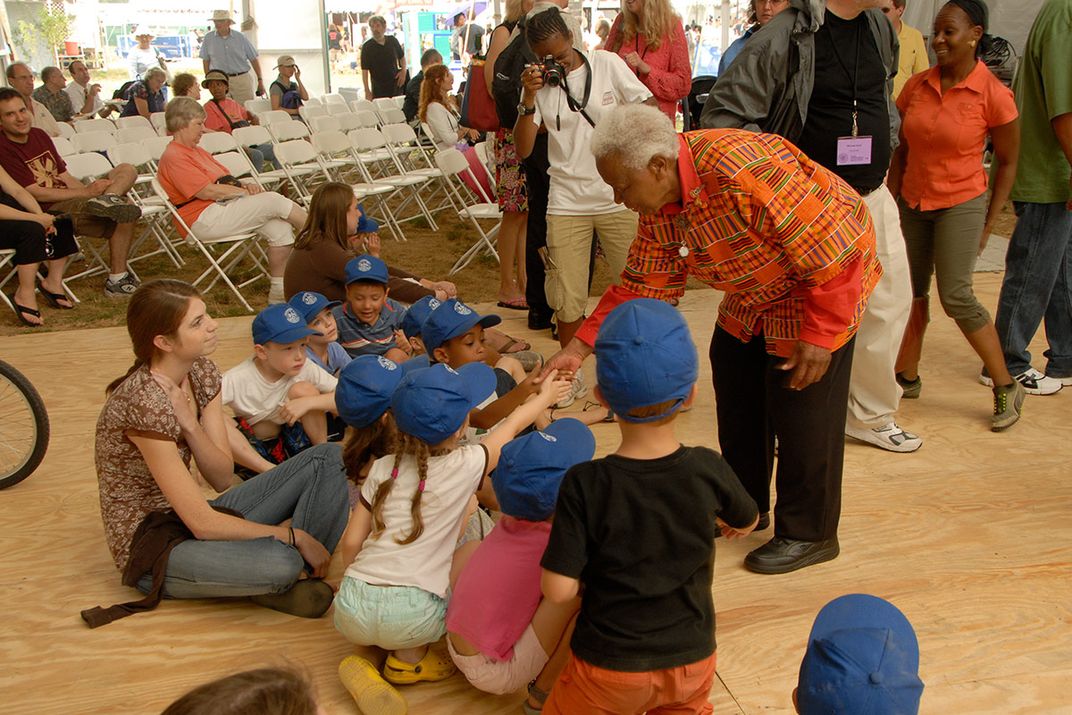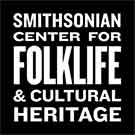SMITHSONIAN CENTER FOR FOLKLIFE & CULTURAL HERITAGE
A Century of Ella Jenkins: Tributes to the First Lady of Children’s Music
To celebrate Ella Jenkins on her hundredth birthday in August, we asked a group of musicians how Ella has inspired them.
:focal(600x400:601x401)/https://tf-cmsv2-smithsonianmag-media.s3.amazonaws.com/filer_public/d1/7a/d17af89a-6b0c-430d-bf8a-20df4e1a0f26/sff2007_tinsley_6-29_0092.jpg)
Over her decades-long career as a beloved musical educator, Ella Jenkins has encouraged children to use participation and individual creativity to sing and learn together. Across forty albums, the “First Lady of Children’s Music” introduced the African American call-and-response form to an enormous audience of eager listeners and taught kids to sing, dance, count, share cultures and traditions, and play musical instruments of all kinds.
A GRAMMY Lifetime Achievement Award winner, she brought her music to the international stage, from our own Smithsonian Folklife Festival to Sesame Street, Barney and Friends, and Mister Rogers’ Neighborhood. Each of Ella’s albums is a monument to her legacy of fostering compassion and mutual understanding through music.
To celebrate Ella Jenkins on her hundredth birthday in August, we asked a group of musicians how Ella has inspired them. Children’s music luminaries Raffi, Elizabeth Mitchell, José-Luis Orozco, Dan + Claudia Zanes, Mr. Greg, and Kristin Andreassen join with “The American Songster” Dom Flemons and Smithsonian Folkways archivist and curator Jeff Place to sing her praises. Listen in and read on below!
A Foundation of Folkways
The day Ella Jenkins brought a demo of herself singing a children’s song to Moses Asch in 1956 was important for her future and for Folkways Records. The label had always had children’s music as a major part of its catalog, but she became one of their bestselling artist for decades to come. Ella’s sales made it possible for Asch to create a wide-ranging catalog of albums including tribal music and science sounds, which otherwise would not have supported themselves.
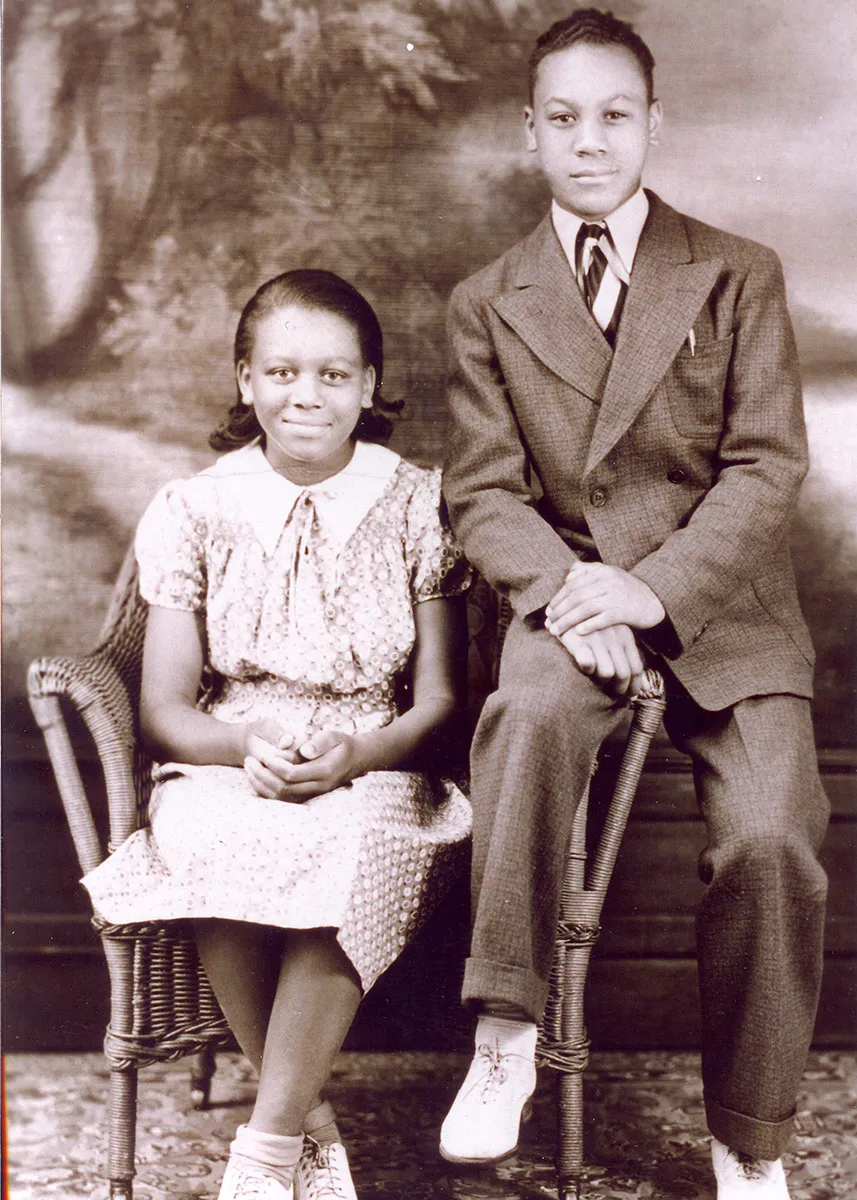
Ella was born in 1924 in St. Louis and grew up in Chicago. Her neighborhood was blessed with lots of music. She had an uncle, Uncle Flood, who played music and taught her harmonica. He introduced her to the music of Chicago.
She went to San Francisco State University and studied sociology, child psychology, and recreation. She got a job at the YMCA in the 1950s singing with teens and creating programs that incorporated world music. She has always been good at getting children to sing along—frequently to call-and-response songs. These talents led her to host the Chicago public television show This Is Rhythm. The theme of rhythm was central to her programs and later work. By the time she went to see Asch at Folkways, she had decided to devote her life to music.
Asch sold most of Folkways’ titles to schools and universities. He spent much time attending educational conferences and invited Ella to attend as well—often resulting in “Ellamania” with teachers lined up to meet her.
The first thing the Smithsonian did after acquiring Folkways in 1987 was make sure all of Ella’s records were in print. As soon as the compact disc appeared, Smithsonian Folkways created about forty titles in the format; roughly half were Ella’s.
Working with her manager Bernadelle Richter, Ella has had a very successful career. She attended educational conferences with Smithsonian Folkways, and at each she continued to be a star. Eventually there were three generations of teachers who had all come up with and used her music. Going out with her, I experienced people coming up and thanking her. Once, walking through the Smithsonian to a meeting, she encountered a group of children and, of course, had to start up a sing-along.
Now, we celebrate one hundred years of Ella in our world. People are coming together to acknowledge it. Big happy birthday, Ella.
—Jeff Place, Smithsonian Folkways senior archivist and curator
Warm Way with Songs
Ella Jenkins has been a pioneer in making music that kids can make their own. She has had a warm and engaging way with songs. Ella’s classic “You’ll Sing a Song” is on my latest album, Penny Penguin. Happy birthday, dear Ella!
—Raffi, children’s musician
Our Shining Star
We’ve never known a world without Ella Jenkins. She was singing when we arrived on Planet Earth, singing when we were growing up, and singing when we began to feel the call to bring our own music to young people. She’s been our shining star all along and will continue to light the way for countless others who choose this path.
We’re inspired by the musical simplicity and emotional cultural depth of her music. Unions! Friendship! Black folk songs! Rhythms! Camp songs! Seasons! Numbers! Multiculturalism! Call and response!
Coming out of a concert years ago, we overheard a girl turn to her dad and say, “I think Miss Jenkins only played three songs.” She was right! For an hour, using three songs, four strings of a baritone ukulele, one voice, and all of us, she created an entire universe. And in it she gave people of all ages the sense that in this musical life, all things are possible.
—Dan + Claudia Zanes, children’s musicians and Folkways artists
Listen to Dan + Claudia Zanes’ tribute to Ella Jenkins.
Promoting Diversity and Friendship
I first learned about Ella Jenkins in the early ’70s when she was teaching at San Francisco State University. At that time, I was working in the bilingual-multicultural programs of five school districts in the San Francisco Bay Area: Berkeley, Oakland, Richmond, Union City, and Daly City.
We met at the National Association for the Education of Young Children and California Association for the Education of Young Children conferences, and we performed together with other children’s music singers. I liked Ella’s repertoire of children’s songs from all over the world, her charisma, and the delivery and interaction with children, which was unique. At different times in informal encounters at these conferences, Ella was very proud to sing in Spanish the Mexican song “Bésame Mucho.”
It was always a great pleasure to see Ella’s performances and to collaborate with her in promoting diversity, friendship, and multicultural traditions through children’s music, songs, and games.
—José-Luis Orozco, children’s author, musician, and Smithsonian Folkways artist
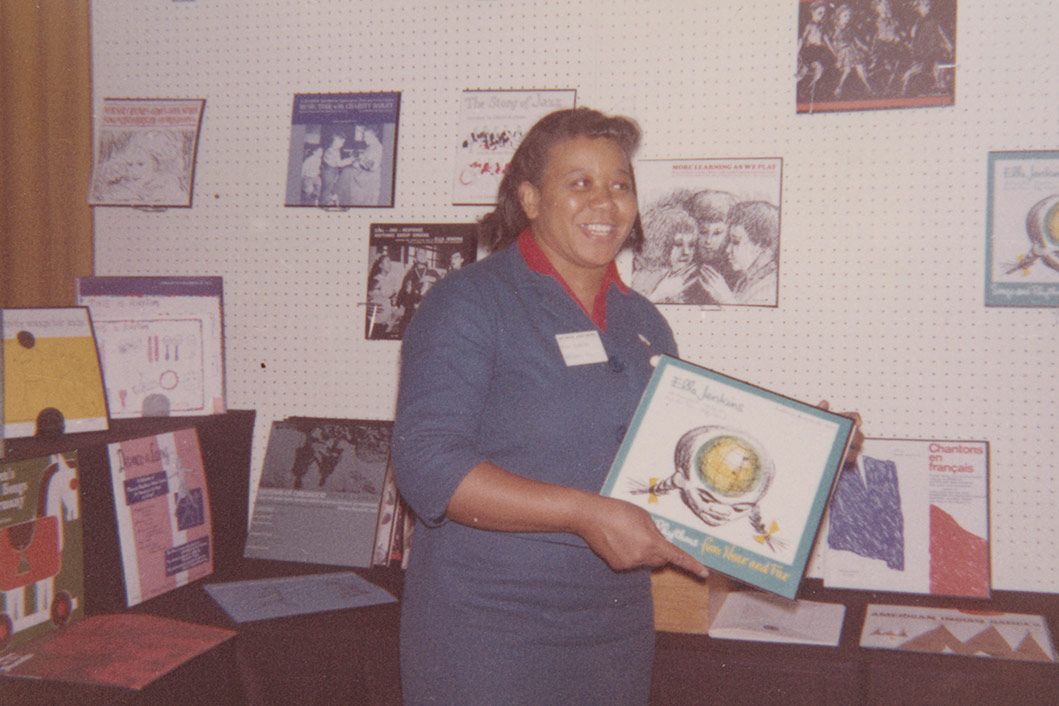
A Gift of Rhythm and Rhyme
The ingredients for what it takes to be a good, well-rounded human being can be found within the Ella Jenkins songbook. Over the last fifteen years as a preschool teacher, I have used Ella’s discography as an aurally attractive tool to help develop a classroom environment full of compassionate, creative, music-loving, value-driven young learners.
My students learned what it means to be good stewards of the earth by engaging in upcycling art projects and beach cleanups inspired by Ella’s songs “A Solution to Pollution,” “Clean Up Week,” and “Environment Game.” The preschoolers learned how to snap, tap, and clap in time while joining Ella in her “Adventures of Rhythm,” and they bonded as a classroom community of choral singers while performing “You’ll Sing a Song and I’ll Sing a Song” during circle time.
The students acquired a slew of new vocabulary through Ella’s musical rhymes, and many were moved to write their own rhyming couplets to Ella’s existing melodies. Rarely a day goes by when Ella’s songs are not enhancing our classroom environment: the preschoolers are dancing to her records as they spin on the turntable, or the students are singing the songs as they work, or the values in her songs are reflected in the way the students show kindness and compassion to one another.
Let’s celebrate Ella on her centennial with a many-layered birthday cake—each layer representing the bounty of rich messages that Ella bakes into her songs. One layer for Ella’s gift of rhythm and rhyme, another for her songs of peace and advocacy for others, the next layer for her songs about friendship and community, topped by a layer for her songs about environmental stewardship and animals, a layer for Ella’s multicultural songs, and, lastly, a layer of cake for Ella’s ability to make learning endlessly fun.
—Gregory Gardner, a.k.a. Mr. Greg, teacher, children’s musician, and Smithsonian Folkways artist
Find Mr. Greg’s Ella Jenkins lesson plans for kindergarten and pre-K students, and listen to his tribute to Ella Jenkins.
The Universal Language
Ella Jenkins is a visionary in so many ways, including her pioneering use of folk music to introduce children to languages and cultures beyond their own.
Years before I had the privilege of meeting and collaborating with Ella, I had taught her songs and listened to her recordings in my classroom. I experienced firsthand her wisdom and prescience about the power of music in early childhood development and community building. I found a copy of her 1979 album Travellin’ with Ella Jenkins, a Bilingual Journey, and it inspired me both as a teacher and a musician. Ella made the album after taking a trip around the world as part of a cross-cultural exchange. From Indonesia to Australia and beyond, she learned new songs and traditions and shared her own vast knowledge of American folk songs with international audiences, handing out as many harmonicas to eager children as she could.
For many years to follow, Ella released albums on Smithsonian Folkways that expressed what she called “Traveling Social Studies”—journeys around the world through song. These releases culminated in her genre-defining Smithsonian Folkways compilation Multicultural Children’s Songs.
Ella has shown us that singing a song with someone can sometimes be the quickest and most beautiful way to make a friend. In Ella’s hands, even when you don’t share a common language, music truly is the universal language that can unite us all.
—Elizabeth Mitchell, children’s musician and Smithsonian Folkways artist
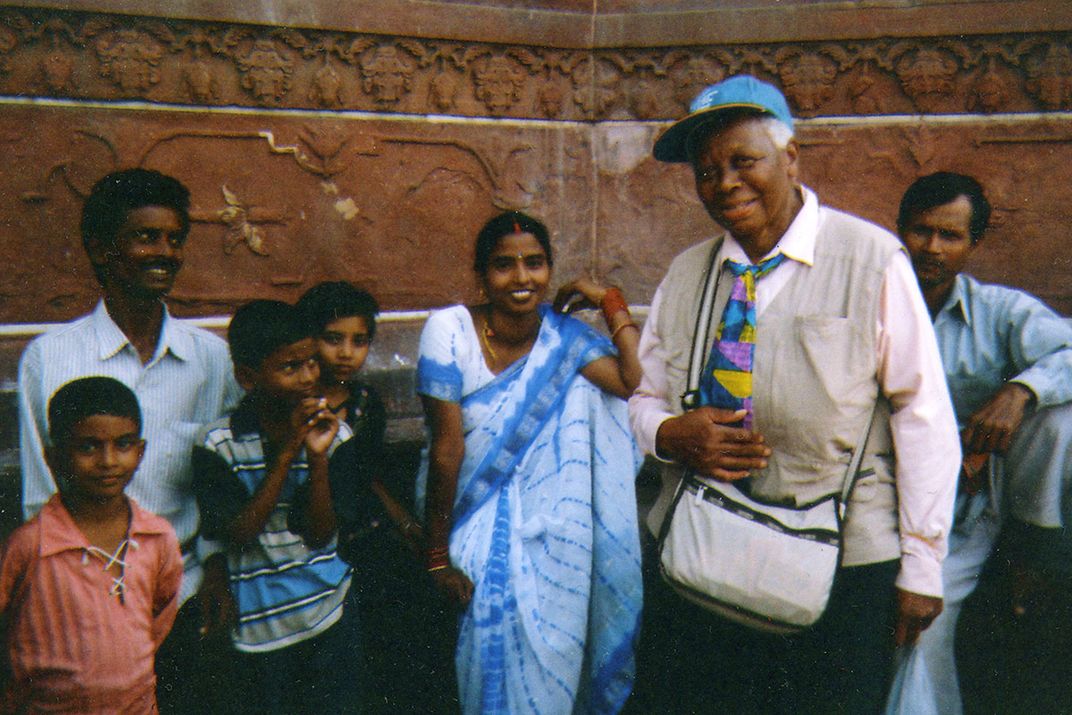
Timeless Connection
I took a long drive with Ella’s catalog on my car stereo and a toddler in the back seat, and there were two big things that struck me. First, I was reminded that my own best-known kids’ song, “Crayola Doesn’t Make a Color for Your Eyes,” wouldn’t be a thing at all if I hadn't grown up on the rhythmic call-and-response playground rhymes that Ella collected and shared. Second, I’m truly humbled by Ella’s direct and timeless connection with her young audience. Nothing I’ve made comes close.
As proof, I heard her newest fan—my two-year-old daughter—clapping along with all three versions of “Miss Mary Mack” on the You’ll Sing a Song and I’ll Sing a Song record. Ella just knew the kids would resonate with the song more if she kept coming back to it. On another track, Ella leaves several seconds of silence right there in the middle of the recording—and sure enough, I heard my daughter whispering the response line. When you take the arrangement right down to one woman with a ukulele and a powerful understanding of children and their growing minds, the kids will do just what mine did. The playlist ended and she said, “More, please?”
—Kristin Andreassen (of the Bright Siders), folk musician and Smithsonian Folkways artist
A Euphoric Feeling of Community
I had enjoyed Ella Jenkins’s records on Smithsonian Folkways for many years before I had the extreme good fortune to meet her in person. That day holds a special place in my heart. I was backstage at a performance workshop at the Old Town School of Folk Music when someone suggested that I should meet her. Delighted at the thought of getting to meet one of the legends of folk music, I waited for her to enter the doorway.
She came in, introduced herself in a humble and unassuming manner, and then asked me and the people I was with if we knew the song “Jambo.” With a few small directions and a confidence that created a magical ambiance for learning, Ella had us all singing together in great harmony and spirit, lifting us to a euphoric feeling of community. Afterward, we parted as friends and colleagues, having shared a song, a video, a smile, and a hope that we would all meet again.
In many ways, this is the brilliance of Ella Jenkins. Armed with a ukulele and an eclectic songbag of uplifting melodies and words, she has created these special spaces for communal singing everywhere she has played all around the world. It’s a wonder that she has been performing for a century, spreading love and music to the most important audience of all: children. She has not only performed—she has recorded a substantial catalog of albums, books, and videos that will cement her legacy in the hands, eyes, and ears of many generations of music lovers-to-be.
The power of connection is what makes Ella so special. It allows her to transcend race, gender, and creed and give people the tools they need to take the music to the next place, whether it’s the stage, the classroom, or the playground. Here’s to one hundred years of Ella Jenkins!
—Dom Flemons, folk musician and Smithsonian Folkways artist
